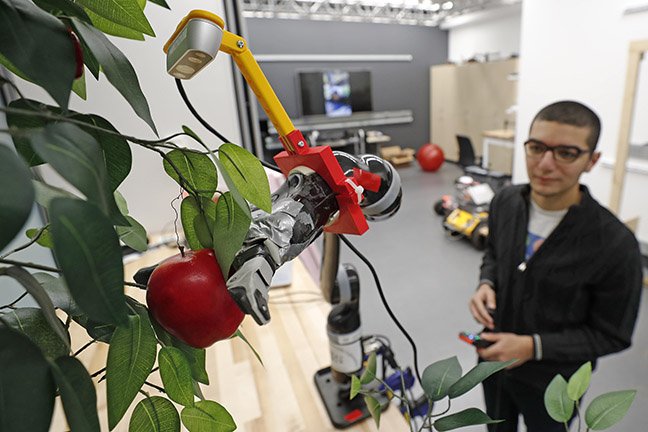University of Minnesota opens new robotics research labs

$13 million lab renovation will accommodate research on ground, water, and aerial robots
MINNEAPOLIS / ST. PAUL (11/07/2018) — Robotics research at the University of Minnesota received a big boost with the opening of new state-of-the-art robotics research labs in renovated space on the first two floors of the Shepherd Laboratories building on the Twin Cities East Bank campus. The renovation was funded primarily by private donations.
The 20,000-square-foot renovation includes nine flexible robotics labs and various work spaces for robotics faculty and graduate students. One lab is two-stories high to accommodate research on flying robots. Other labs will provide space for research on underwater and ground robots. In addition to the robotics labs, the renovation will include about 1,000 square feet of workshop space for the University’s Solar Vehicle Project Team, including an electronics lab, solar array lab, and assembly room as they build their solar car.
“Robotics research is important in so many areas of our lives, including health care, agriculture, the environment, and the automotive industry. We are hoping to make Minnesota a leader in robotics research and bring even more federal and industry research funding into the state,” said Nikolaos Papanikolopoulos, a University of Minnesota computer science and engineering professor and world-renowned robotics researcher.
The Gemini-Huntley Robotics Research Laboratory was funded by $10 million in gifts from Gemini Inc. founders James and Sharon Weinel and Gemini’s CEO Frederick Oss and his wife Siri Jane Oss. The lab has also been named in honor of Gemini Inc. board member Dave Huntley, who helped Gemini become a world-class manufacturer in its industry sector.
The Patrick J. Starr Solar Vehicle Project Laboratory was made possible by a $1 million gift from Clifford I. Anderson and named to honor the advising legacy of College of Science and Engineering Professor Emeritus Patrick J. Starr, who served as the Solar Vehicle Project advisor from 1992 to 2006.
In addition to the $11 million in donations, the University used about $2 million in state funding designated for robotics research through the University’s Minnesota Discovery, Research and InnoVation Economy (MnDRIVE) initiative.
“This project wouldn’t have happened without a combination of both private and public support,” said Mostafa Kaveh, University of Minnesota College of Science and Engineering Dean. “This project shows what great things can happen when both private and public entities come together.”
The University chose BWBR as the design firm for the project. Knutson Construction was the general contractor. The renovation was completed in about a year.
If you’d like to support research or other initiatives within the University of Minnesota College of Science and Engineering, visit our CSE Giving website.
